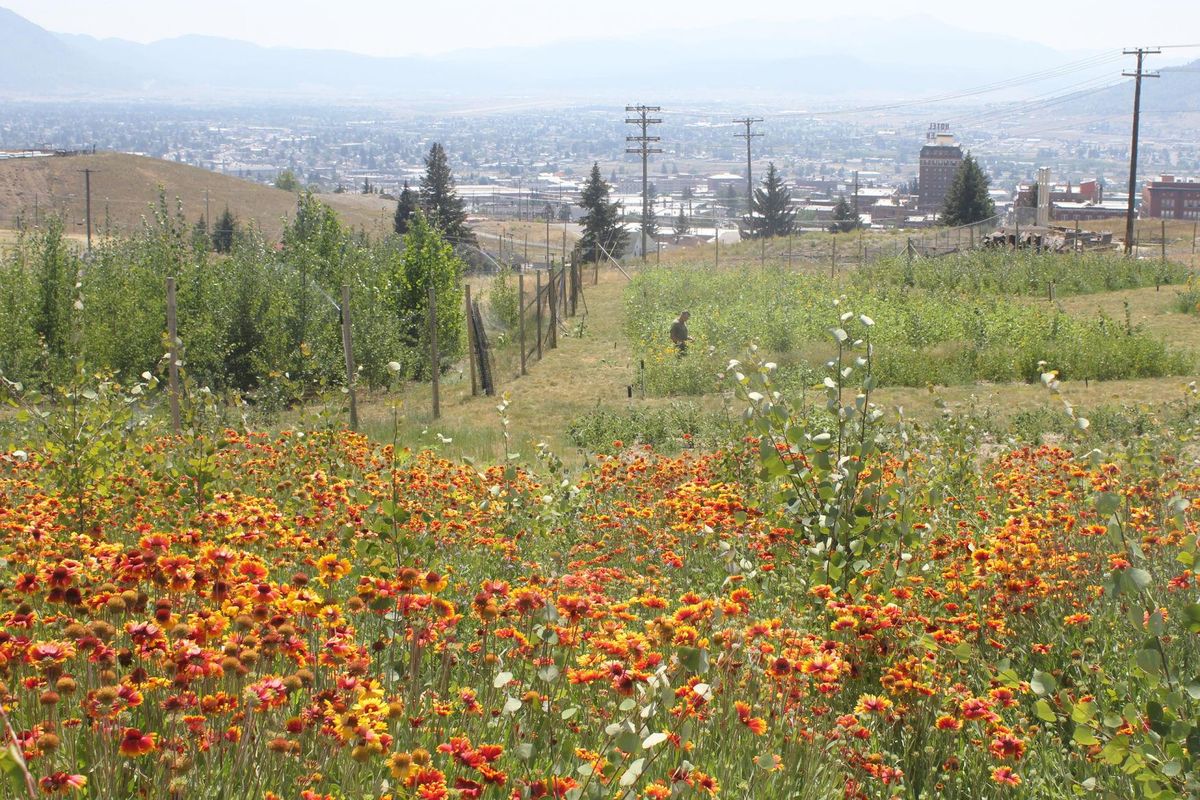Butte mining dump being turned into colorful garden

BUTTE – Walking with Norm DeNeal through the flower gardens and aspen groves he is restoring on the Butte Hill is a little like following Alice in Wonderland down her delightfully mad rabbit hole.
In the midst of acres of flowers and green-leafed trees, wasps and other insects buzzing in the noonday sun, DeNeal calls to his workers and looks at his watch. But he has trouble deciphering the time and day because his watch is set one day behind and two hours and two minutes fast, reported the Montana Standard.
“I’m running on Eastern Standard Time,” he jokes.
While DeNeal, 69, a master gardener, may need help getting the right time and day, his clarity when it comes to building an ecosystem is profound.
Restoring ecosystem
With $272,500 from Butte Natural Resource Damage Council grants, plus a matching grant of $33,500 in water from the county, DeNeal is trying to do more than just plant pretty flowers and trees over nearly 7 acres at the Clear Grit Dump and Mandan Park east of the Steward Mine. He is restoring an entire ecosystem with native flora.
The project, which has expanded as he has received additional grant money from the council, has attracted bluebirds and pine siskins, birds native to this area. A native plant called fireweed came up on its own among the flowers and trees DeNeal planted.
And when DeNeal’s work matures within a few years, residents will be able to enjoy a public garden bursting with native plants and trees.
He says that by growing so much plant life in one place, the plants will be better able to survive once the water is shut off and the seven part-time employees stop weeding the garden.
“When you go up there and look at what he’s done, it’s a refuge for songbirds,” said Natural Resource Damage Program environmental science specialist Pat Cunneen.
Cunneen said meadowlarks and grouse have begun to appear. And, of course, deer have arrived. So much so that DeNeal had to put up fencing to protect the garden. Cunneen said deer footprints are visible around the fencing.
“They want to get into that all-you-can-eat buffet Norm is serving up there,” Cunneen said.
That’s a far cry from what it once was. DeNeal, who started as a teenager working in the Steward Mine, remembers when the hill east of the mine was a dead zone.
“It was a very productive mine,” DeNeal recalls. “There was a lot of waste here.”
While the goal is to put down plants that will hold in place the Butte Hill’s Superfund cap – soil and grass placed on top of mine waste to keep it under control – DeNeal envisions a garden that will attract people as well as wildlife and a place that will tell Butte’s history. He envisions interpretive signage and a garden that is so lush and colorful it becomes an economic driver for the city.
“If you build it, they will come,” he said, talking about more than birds and bees and deer.
Growing within the treasure trove DeNeal has planted are aspen, which he calls “smart trees” because of the way the roots avoid mine waste, plus fir trees and flowers such as penstemon, Indian blanket flower, roses and the city’s flower clarkia – named for the flower’s founder, William Clark. DeNeal also envisions tens of thousands of lupine to come.
“This (hill) will be glorious with lupine,” DeNeal said.
He also will begin work next year on Mandan Park on North Wyoming Street. That will contain a border of aspen trees and native plants, Cunneen said.
Gonzaga grad
The former president of the state’s garden club has never formally studied plants. In fact, despite his expert green thumb, DeNeal doesn’t consider himself a gardener even though he’s had a garden of his own since he was 7.
DeNeal left Butte on his 20th birthday to study philosophy at Gonzaga University. After graduating from there, he won a scholarship to Cambridge University in Cambridge, England, where he studied philosophy and theology for four and a half years.
But DeNeal has neither a bachelor’s nor a master’s degree from either university. He has a European degree called a licensure.
DeNeal returned to Butte exactly 20 years to the day he left. Arriving on his 40th birthday, he came back after 15 years spent in Seattle as a woodworker. He returned to help care for his ailing mother. After his mother died, DeNeal opted to remain.
That’s because the plant savant felt he’d gained a new perspective on his hometown.
“I was like, ‘Wow. It’s not an ordinary town. This is an extraordinary town,’ ” DeNeal said.
DeNeal has created other areas around Butte – the Lexington Gardens and the hill on Shields Avenue next to the Berkeley Pit viewing stand – where he has landscaped small oases of green space.
The day DeNeal drove a Montana Standard reporter around town to look at his work, a couple were picnicking atop the Lexington Gardens. The breathtaking view of the Summit Valley was spread out before them under a clear blue sky while surrounded by colorful flowers and the headframe.
“There was a time when not a single weed grew in uptown Butte,” DeNeal said. “The city would benefit from a glorious landscape.”